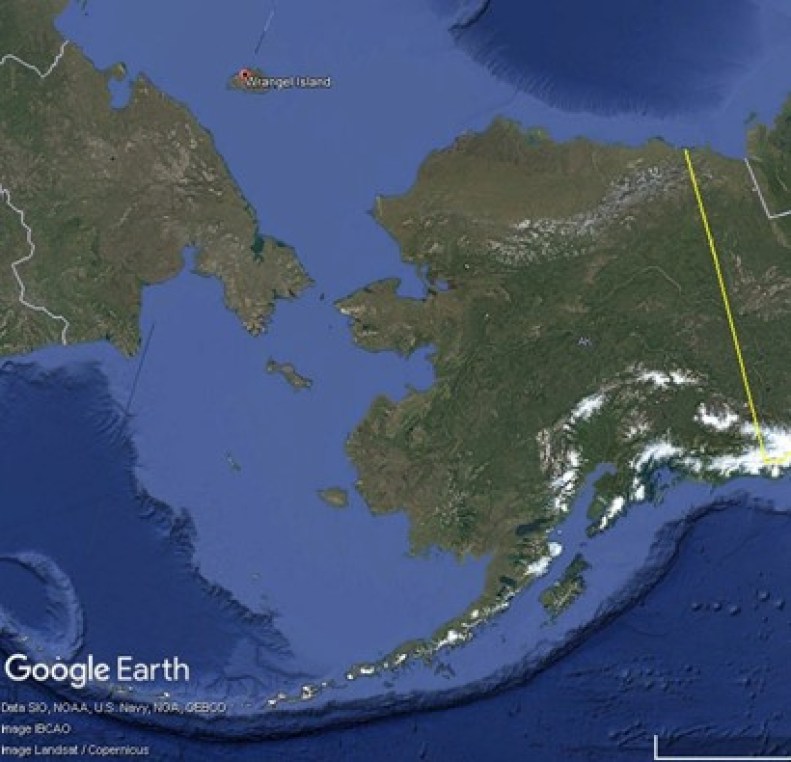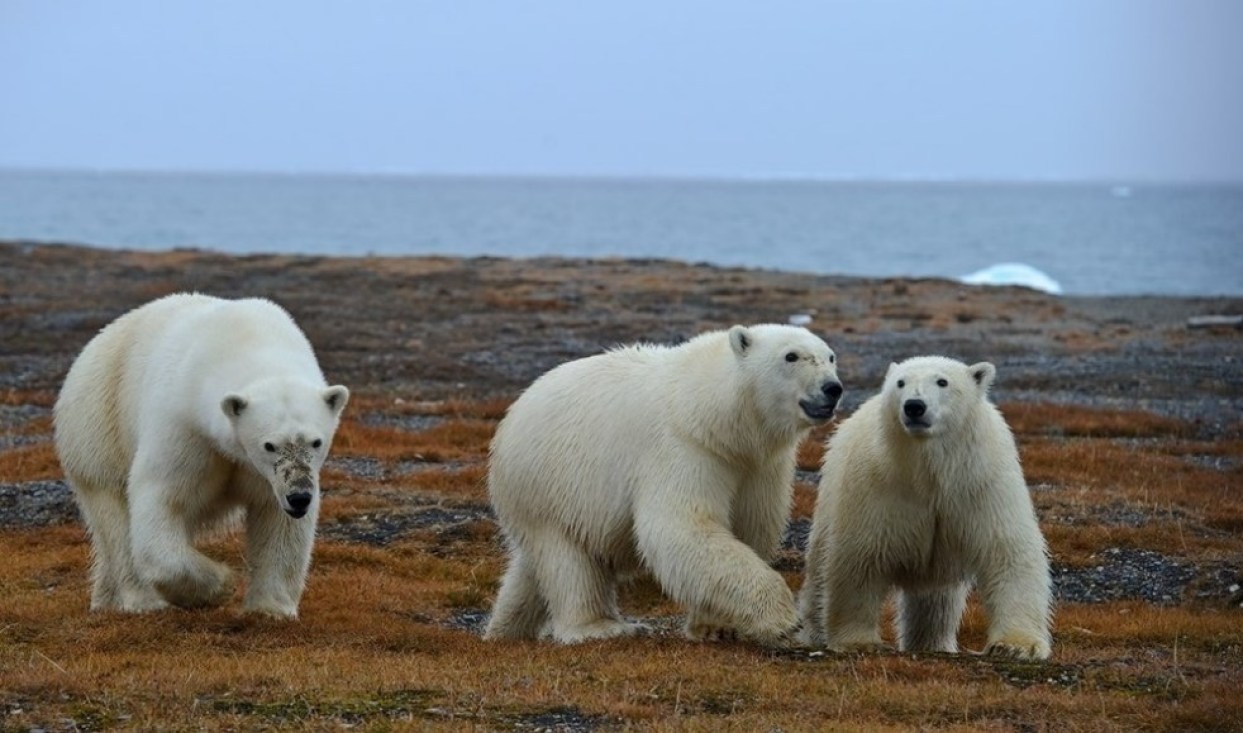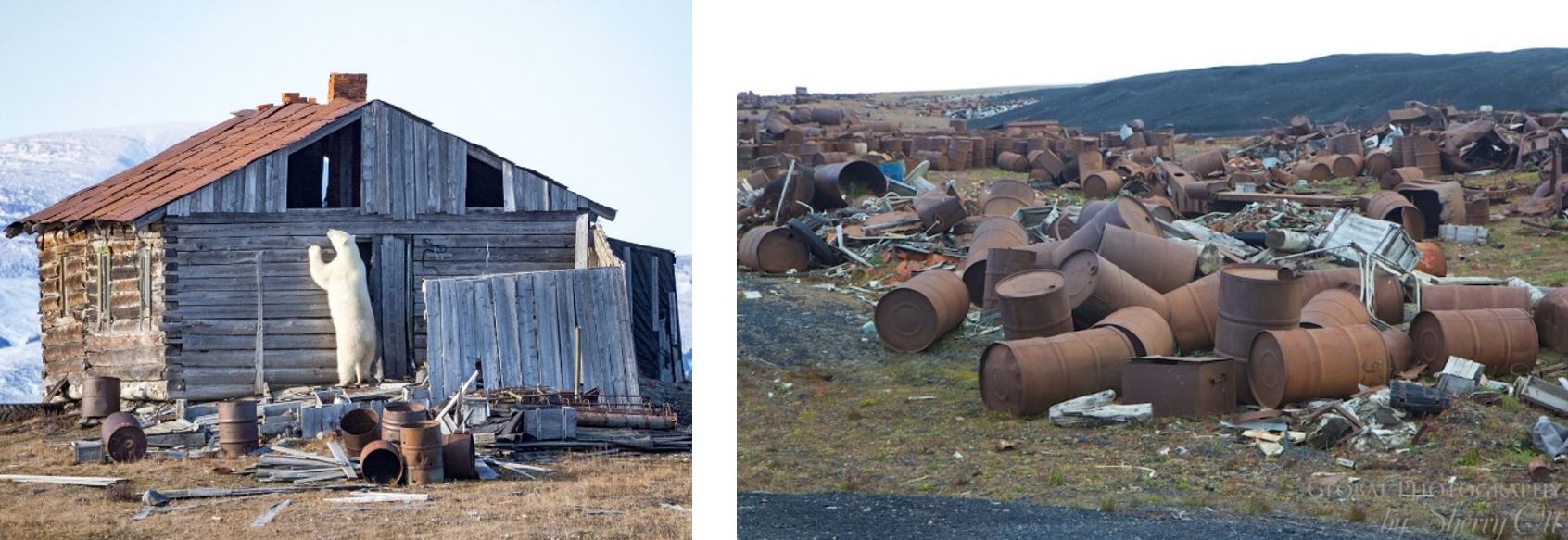“For more than 100 years, Russia has illegally occupied Wrangel Island, an American-claimed island in the Arctic, and has now fortified it with a military base…Russia’s Ushakovskoye facility on Wrangel Island starkly illustrates Arctic imperialism: a protected sanctuary despoiled by an illegal, military base on disputed American territory.” — Brandon J. Weichert, for The National Interest, September 3, 2025.
Wrangel Island, in the Arctic Ocean between the Chukchi Sea and East Siberian Sea, is positioned 310 miles northwest of Alaska, and only 88 miles from the Siberian coastline of Billings, Russia. It measures 92 miles long by 50 miles wide. On August 14, 1867, American whaling ship captain Thomas W. Long discovered the island and named it for Baron Ferdinand von Wrangel, Baltic-German explorer and admiral in the Imperial Russian Navy, although Baron von Wrangel never actually visited the remote island.
On August 12, 1881, a landing party from the USRC Corwin revenue cutter arrived on the island and officially claimed it for the United States, as “New Columbia,” under the Guano Islands Act. This was a very valid claim. The famous naturalist John Muir was a member of this group, and he published the first description of Wrangel Island less than two weeks later.
But in 1911, two Russian military icebreaker ship crews landed on the island, and in 1916, the Czarist government declared that it belonged to the Russian Empire. In 1924, the Soviet Union illegally removed American, British, and 13 Inuit settlers from the island.
Soon afterward, there was another American attempt under Secretary of State Charles Evans Hughes to claim the island for the United States, but in 1926, the Bolshevik government of the Soviet Union reaffirmed the Czarist claim to sovereignty over Wrangel Island, sending a team of Soviet explorers to live there for several years.

The island is certainly an interesting location, with an unusual history and very rare biodiversity. Most of it is a protected wildlife sanctuary, administered since 1975 by Russia’s Ministry of Natural Resources and Environment. It has been a UNESCO World Heritage Site since 2004, and research published in 2017 indicates that Wrangel Island was believed to have been the very last place on Earth supporting a population of 500 to 1,000 woolly mammoths, until about 2000 B.C., whereas most mammoths in North America and Eurasia had died out by 8000 B.C. Currently, the island is a breeding ground for polar bears, with the highest density of polar bear dens in the world.

Wrangel Island is also home to over 60 mammal species, including musk oxen (introduced in 1975), Arctic foxes, wolves, wolverines, domestic reindeer (introduced in 1948), seals, lemmings, and Pacific walruses. There are also many breeding colonies of migratory birds, including geese, snowy owls, gulls, puffins, cormorants, long-tailed ducks, sandpipers, and other species.
In 2003, the only human inhabitants were four year-round rangers, and perhaps a dozen scientists in the summer months. But in 2014, the Russian Navy announced plans to establish a base on the island, at Ushakovskoye, on the southeastern coastline.

Named after explorer Georgy Ushakov, the Ushakovskoye military facility is at the forefront of Russia’s aggressive posturing in the Arctic region. The new base’s primary feature is the 12A6 Sopka-2 (“Hill-2”) state-of-the-art, ground-based, air surveillance radar, entering service on the island in 2016, with a range of approximately 248 miles. It’s installed on a hillside, 590 feet above sea level, facing Alaska.

The radar itself is mounted atop a rugged, steel tower, approximately 70 feet tall, for improved line of sight, and the phased-array antenna is covered by a white, protective, environmental dome, which can withstand temperatures down to 40 degrees below zero Fahrenheit and 90 miles per hour winds.

Wrangel Island is 1,186 miles northeast of the nearest Russian air base, Klichi-20, which has an An-26 Curl transport aircraft with a range of up to 1,600 miles, but there is no runway on the island for fixed-wing aircraft, so resupply by the air force is not possible.
But Ushakovskoye is, after all, a naval base, apparently resupplied by the Russian Pacific Fleet at Petropavlovsk-Kamchatsky, with numerous ships of all types, and naval helicopters, such as the Ka-27M Helix-A modified, utility transport, or the Ka-29TB Helix-B aerial gunship, armed with a 7.62mm Gatling gun, a 30mm cannon, 80mm rockets, and four to eight AT-6C Spiral anti-tank missiles. There is a helicopter landing pad at the Ushakovskoye base, only 110 yards from the southern shoreline.

This blatant militarization of a UNESCO World Heritage Site and wildlife sanctuary poses internal threats from Soviet-style pollution, including fuel spills, construction debris, carbon emissions, and rusty, garbage dumps everywhere, damaging the delicate ecosystem and upsetting the balance of nature.
But there is also the severe, geopolitical threat of the Russian Federation fortifying the Arctic regions and refurbishing as many as 50 former-Soviet bases in the Arctic areas. Wrangel Island currently serves as an illegal, early-warning, radar outpost, providing real-time intelligence on U.S. military movements near Alaska. In fact, the Sopka-2 is a cueing radar, collecting data that can be transmitted to more powerful radars located closer to the Russian mainland, so it’s part of a comprehensive network.
Thomas Emanuel Dans, a commissioner of the U.S. Arctic Research Commission in 2021, has stated that there has never been any formal acceptance of Russia’s territorial claim to Wrangel Island, so it officially remains a U.S. possession. “What’s changed here has been the invasion of Ukraine, and with it, issues of sovereignty and territorial integrity are now front and center,” he told the media. “There’s never been an acceptance of any other nation’s claim to them.” (Meaning Wrangel Island and the De Long Islands.)
A Russian foreign ministry spokesman recently stated that Russia’s sovereignty over Wrangel Island “is not disputed by the U.S. administration,” and that any “attempts to rewrite history, are obviously counterproductive and fraught with consequences. Our country has full sovereignty over this northern territory…We do not think that the authorities in Washington will take the risk of raising the territorial issue in relation to the Russian-American border on any serious level.”
Russia is in the process of completing six military bases in the far north; on the New Siberian Islands, Alexandra Land, the Severnaya Zemlya archipelago, Novaya Zemlya (Rogachevo), Mys Shmidta, and Wrangel Island, effectively forming a multi-layered, military, defensive shield.
According to Russian media reporting, the Sopka-2 complex was primarily used in 2019 to locate aircraft or aerial objects equipped with stealth (low observable) technology, specifically referring to its intelligence-gathering capabilities against the U.S. Air Force F-22A Raptor and F-35A Lightning II stealth fighters stationed at Elmendorf and Eielson Air Force Bases in Alaska. In addition, Fort Greely army base has 44 to 64 Ground-based Midcourse Defense interceptors for destroying any inbound, North Korean or Chinese ballistic missiles, so Alaska is a region of strategic, military importance.
American fighter aircraft there are constantly intercepting Russian, nuclear-capable bombers, provocatively entering Alaskan airspace, so international tensions remain high, especially considering that Russia is currently fighting a full-scale war in Ukraine, and the U.S. president is attempting to mediate a peace deal.
Russia has also developed a special, Arctic version of its Pantsir-S1 (SA-22A Greyhound) short-range, surface-to-air missile system, with an effective range of 11 to 19 miles, depending upon the missile variant employed. These have already been deployed to the Northern Fleet area, and will likely be used to defend Wrangel Island in the near future.


In conclusion, the recent Russian militarization of the Arctic regions, especially Wrangel Island, which is formally a U.S. possession, poses both environmental and geopolitical dangers and threatens our national security in an uncertain world. This critical development must be closely monitored to ensure there is no escalatory expansion of Russian military forces in the region.

